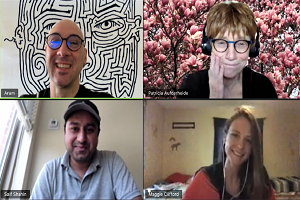Communications
For SOC Researchers, Working Remotely is Business as Usual

The campus is quiet, the doors of McKinley locked tight, but for School of Communication scholars, work continues as usual. Long before coronavirus-imposed travel restrictions and social distancing, researchers regularly worked remotely, collaborating with colleagues at other institutions around the world. In recent years, web-based technologies have enabled scholars to connect, partner, and share their results as never before.
Academics have always worked remotely to some degree. All scholars build upon the published ideas of others, most of whom they will never meet. And some of the most successful collaborations in communication studies were carried out across institutions and borders.
Harold Lasswell and Abraham Kaplan, whose analysis of wartime political communication and political influence is detailed in their classic “Power and Society,” were separated by a continent. More recently, scholars like Eszter Hargittai of the University of Zurich and Amanda Hinnant of the University of Missouri, co-published groundbreaking research on inequality in the use of digital information.
Similarly, School of Communication professors and PhD students have sought to expand the scope and impact of their research by collaborating with colleagues across the country and around the world.
The work of Professor and PhD Program Director Patricia Aufderheide is a notable example. One ongoing project, which began in 2004, focuses on understanding how knowledge of U.S. copyright law affects the work of teachers, journalists, librarians, filmmakers and other artists. That effort is described in her 2018 book “Reclaiming Fair Use: How to Put Balance Back in Copyright.”
Aufderheide was one of several principal investigators from multiple institutions supporting the initiative. At every phase, contributors relied heavily on online tools to keep their projects moving. They have communicated through email, Skype, Slack, and Google Docs. To brainstorm conference presentations as a group, they created Wikis. For outreach and education, they have used webinar platforms including WebEx, Zoom and GotoMeeting. They also engaged film, web, and game design students to help tell the story online, through films, games and infographics. Finally, they also published their work through traditional academic venues, preferring online and open-access journals, providing some PhD students with their first opportunity to publish.
In another recent example, Aufderheide and SOC PhD student Atika Alkhallouf, worked remotely with colleagues from the New School in New York to investigate threats to the future of what they term “public podcasting.” Their conclusions were subsequently published in an online, open-access academic journal, and also covered in an online newsletter aimed at podcast producers. They did all the interviews by phone and Skype, all the literature research through their university libraries' portals, exchanged documents via Google Docs and email, and met by conference call, WhatsApp and Facetime.
“As we move all our operations online, one thing we’re learning is how many skills we already have in working remotely,” Aufderheide said.
Associate Professor and Chair of Communication Studies Aram Sinnreich has also had good results working remotely, and he continues to collaborate on multiple projects with scholars around the world. He recently finished a book proposal with co-author Jesse Gilbert, which aims to expand upon ideas from “The Carrier Wave Principle,” their recent article in the open-access, online journal The International Journal of Communication. Although Gilbert is based in Los Angeles, distance was no impediment to writing either the article or the book proposal. They completed the work, and invited commentary from fellow scholars, using only email, Google Docs, Slack, and the occasional telephone call.
Sinnreich is also co-authoring a novel with his sister Rachel Hope Cleves, a historian who works at University of Victoria, in British Columbia. They use Slack to communicate about the book, with different channels dedicated to different aspects of the story and process. Now in the writing phase, they also work in Scrivener, an application designed specifically for book authors, using a shared manuscript draft hosted on the cloud storage service DropBox. Regular phone conversations, to review drafts and edit in real time, keep the project on track.
“If something as open-ended and creative as a novel can be coauthored remotely using online tools,” Sinnreich said, “then empirical research, using templated structures and observable data, is even more feasible. Our faculty and students should be able to continue producing impactful and insightful scholarship, regardless of social distancing.”
Professor Aufderheide acknowledges challenges when collaborating in the cloud. For example, some colleagues are slow to adopt new applications, and may even be slow to open emails. “That’s when you get really creative about the subject line,” she said. But overall, she is optimistic about the future of remote collaboration. She said, “The digital era has opened up a world of collaborative possibilities that allows us to dream big and work across borders as never before.”
